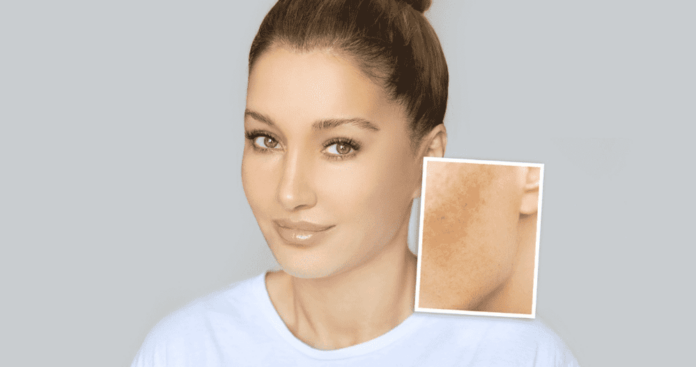Fast Facts About PCOS
-
About 10% of young women and teens have PCOS.
-
PCOS cannot be cured, only managed.
-
PCOS is the most common cause of infertility in women.
-
PCOS can make weight loss hard.
-
The hallmark feature of PCOS is hormonal imbalance.
-
50-70% of women with this condition are insulin resistant. If left unmanaged, PCOS will cause diabetes.
Introduction
For years, many women have attributed their near-absent menstrual periods, skin, hair, and body issues to genetics, stress, and environmental factors. While this isn’t exactly false, it is not the whole truth.
PCOS, Polycystic Ovarian Syndrome is an endocrine condition that affects one in 10 women worldwide. ( 1 ) It causes worrisome symptoms like weight gain and irregular menstrual periods. It can also affect a woman’s appearance and drastically influence confidence levels.
Women with PCOS do not get the same results as other women when they try conventional skin care methods. This is because of the crucial role hormones play in skin management. Learn about PCOS and how it affects your skin in this article.
What is PCOS?
We once defined PCOS as a hormonal condition that causes enlarged ovaries surrounded by cysts. However, recent research reveals that not all women with PCOS have these fluid-filled cysts surrounding their ovaries. Furthermore, even women without PCOS may develop cysts around their ovaries. ( 2 )
A more comprehensive definition would be that PCOS is a hormonal disease that causes women to release large amounts of testosterone ( 3 ), a hormone that ought to only be present in minute quantities.
While the exact cause of this hormonal imbalance remains unclear, it has been linked to genetic and environmental conditions (4). You are more likely to have PCOS if your mother or sister has the condition too.
PCOS causes symptoms like ( 5 )
-
Irregular or infrequent periods
-
Very light or short periods
-
Excess body hair, especially on the chest, stomach, chin, and back
-
Abdominal weight gain and obesity
-
Oily, acne-prone skin
-
Hair loss and male-pattern baldness
-
Skin tags around the neck folds or armpits
-
Infertility and miscarriages
-
Enlarged ovaries
-
Dark, thick patches of skin on the back of the neck, armpits or under the breasts.
PCOS Summary
-
PCOS is a hormonal disorder that causes women to release too much testosterone.
-
The hormonal imbalance in PCOS is responsible for the skin and fertility issues the condition causes.
-
PCOS also causes excessive hair growth in women, especially around the chin, chest, and back.
-
Women with PCOS may have abnormal non-cancerous growths. ( 6 )
How Does PCOS Affect My Skin?
Certain skin conditions bear strong ties to PCOS ( 7 ). In fact, these dermatologic conditions have now become a cardinal diagnostic criterion for the condition. About 60% of people with serious skin conditions actually have PCOS ( 8 ).
-
Acne
PCOS causes acne ( 9 ) by interfering with the stimulation of the pituitary gland. The pituitary gland, called the master gland, signals other glands to release their hormones. In PCOS, the pituitary releases more androgens than normal. These androgens then make the skin produce more sebum, an oily substance that clogs pores, causing whiteheads and blackheads.
When these clogged pores get infected, you get a pimple. With PCOS and poor management, these may even become cystic acne.
Problem areas for people with PCOS include the face, neck, chest, and upper back.
-
Hirsutism
Hirsutism is a major concern for women with PCOS. Hirsutism is the medical term for excessive hair growth in women, especially when the hair growth follows a male pattern. This means growing a beard or mustache, hair on the chest, and excessive hair on the arms.
This particular manifestation of PCOS quickly drives women to hair removal techniques like the use of depilatory creams and frequent shaving. Unfortunately, such procedures are at best exhausting. Certain techniques such as dermaplaning, may stimulate more hair growth and even activate more sebum production, leading to acne. Furthermore, dermaplaning may cause tiny abrasions in the skin which worsen skin texture and inflammation.
Thus, hirsutism itself may cause acne if not properly managed.
-
Seborrheic Dermatitis
Seborrheic dermatitis ( 10 ) is an inflammatory skin condition characterized by dry, red patches of skin. It is caused by a fungal infection and may be itchy. Seborrheic dermatitis occurs when fungal spores settle in pores or hair follicles clogged by sebum. Seborrheic dermatitis is yet another implication of excess androgens, the root cause of excessive sebum production.
The causative organism in seborrheic dermatitis is a yeast fungus called Malassezia. Although this fungus is naturally present on the skin as normal flora, it tends to overgrow during periods of stress, immune deficiency, or hormonal fluctuations, as seen in PCOS.
Problem areas in seborrheic dermatitis include the scalp, face, chest, and back.
-
Acanthosis Nigricans
Acanthosis nigricans is a skin condition that causes dark, thick skin to form wherever the skin folds. This condition affects the neck, armpits, and groin.
Acanthosis nigricans is caused by insulin resistance, a manifestation of PCOS. Insulin is the hormone that controls blood sugar levels. It is released from the pancreas. In PCOS, your cells become less sensitive to insulin. Thus, even though insulin is released, glucose levels remain high. Your pancreas then releases even more insulin in a bid to balance the amount of glucose circulating.
However, this excess insulin stimulates cell growth instead. In high concentrations, insulin causes the multiplication of skin cells, resulting in acanthosis nigricans.
How Do I Know if I Have PCOS?
PCOS exists in a spectrum. As such, there’s no single test that can confirm PCOS. The symptoms of PCOS are many and can vary from woman to woman. Medical professionals use a set of diagnostic criteria to help them recognize PCOS and its many manifestations. These criteria include:
-
Symptomatic assessments
Your physician will begin by confirming if you’ve witnessed irregular periods, had a miscarriage in the past, or usually have less than nine periods in one year.
-
Diagnostic tests
This includes blood tests for excess androgen (testosterone) levels. They may also perform a blood sugar test for diabetes and insulin resistance.
-
Pelvic exams
Although not all women with PCOS have cysts, it still remains a valid diagnostic criterion. A pelvic exam may be able to detect swollen ovaries. This may be followed by an ultrasound to visualize any cysts suspected.
-
Dermatologic assessments
The presence of skin conditions like hormonal acne and hirsutism may help make diagnosis easier.
-
Presence of comorbid conditions
Other conditions that cause hormonal fluctuations, such as Cushing’s syndrome, must be eliminated before a conclusive diagnosis is made.
To be diagnosed with PCOS, you must meet at least two of the following diagnostic criteria:
-
Irregular menstrual periods
-
High serum androgen levels
-
Presence of ovarian cysts
How Do I Manage Skin Problems With PCOS?
PCOS is a lifelong condition. It cannot be cured, only managed. That said, certain medications and habits can make PCOS more bearable. It is possible to manage PCOS such that you do not experience any of its physically-altering symptoms.
-
Oral contraceptive pills
Oral contraceptives, also called birth control pills contain synthetic derivatives of estrogen and progesterone, which counteract testosterone. OCPs help manage PCOS ( 11 ) by regulating periods and preventing excessive hair growth.
OCPs are also a great option for women predisposed to endometrial cancer, which may be caused by infrequent ovulation.
However, OCPs must be used with caution in women with hypertension, a family history of stroke, blood clots, or certain kinds of cancer. Always consult your physician before commencing OCPs.
-
Anti-androgenic medication
Anti-androgenic medications are not the first choice for PCOS treatment, but they can abate certain symptoms such as facial hair growth, acne, and male pattern hair loss. Some anti-androgenic medications include spironolactone and flutamide, with the latter having more side effects than the former.
With this class of medication, it may take as long as six months before you see any significant improvements.
-
Topical treatment
This includes weekly exfoliating treatments like retinoids ( 12 ), lactic acid, and glycolic acid. PCOS-related skin diseases also respond well to chemical peels. Topical antibiotics and corticosteroids like Benzoyl peroxide, Clindamycin, and hydrocortisone should be used with discretion.
-
Laser hair removal
Laser hair removal is the safest hair removal method available for women with PCOS. It is a semi-permanent procedure but may require multiple sessions to achieve the desired results.
Lifestyle Modifications for PCOS
-
Use a good, non-occlusive moisturizer
PCOS makes skin dry, flaky, and prone to irritation. With a good moisturizer, you can prevent the redness and itchiness that comes with the condition. It is also important to use a non-occlusive moisturizer, especially if you have oily skin.
-
Diet and exercise
A simple rule for women with PCOS is to eat more fiber and lean protein than sugars and carbohydrates. This guideline helps them regulate insulin without medication and reduces the appearance of acanthosis nigricans.
-
Always consult a specialist
Worsening skin conditions is a telltale sign of poorly managed PCOS. If you’ve been diagnosed with the condition, don’t ignore your symptoms or assume that you must live with them. If your acne starts to get worse, visit your gynecologist or dermatologist for a comprehensive examination. Early intervention can help you prevent more serious conditions like diabetes and infertility.
Bottom Line
PCOS can cause acne, excessive hair growth, male pattern baldness, dark, red patches around the neck, armpit, and back and areas of thickened folded skin. However, these symptoms can be kept at bay by resolving the underlying hormonal imbalance. PCOS management involves using oral contraceptives, anti-testosterone drugs, and topical treatment.
Lifestyle modifications are also an important aspect of PCOS treatment. A good skincare regimen, a diet plan, and frequent exercise make a significant difference in PCOS treatment results.
References
-
Lizneva, D., Suturina, L., Walker, W., Brakta, S., Gavrilova-Jordan, L., & Azziz, R. (2016). Criteria, prevalence, and phenotypes of polycystic ovary syndrome. Fertility and sterility, 106(1), 6-15.
-
https://www.hopkinsmedicine.org/health/conditions-and-diseases/polycystic-ovary-syndrome-pcos.
-
McCartney, C. R., & Marshall, J. C. (2016). CLINICAL PRACTICE. Polycystic Ovary Syndrome. The New England journal of medicine, 375(1), 54–64. https://doi.org/10.1056/NEJMcp1514916
-
https://www.nhs.uk/conditions/polycystic-ovary-syndrome-pcos/causes/.
-
Zehra, B., & Khursheed, A. A. (2018). Polycystic ovarian syndrome: symptoms, treatment and diagnosis: a review. Journal of Pharmacognosy and Phytochemistry, 7(6), 875-880. https://www.phytojournal.com/archives?year=2018&vol=7&issue=6&ArticleId=6290&si=false
-
Peitsidis, P., & Agrawal, R. (2010). Role of vascular endothelial growth factor in women with PCO and PCOS: a systematic review. Reproductive biomedicine online, 20(4), 444-452. https://www.sciencedirect.com/science/article/pii/S147264831000009X
-
Lee, A. T., & Zane, L. T. (2007). Dermatologic manifestations of polycystic ovary syndrome. American journal of clinical dermatology, 8(4), 201–219. https://doi.org/10.2165/00128071-200708040-00003
-
C.B. BUNKER, JULIA A. NEWTON, JULIE KILBORN, ANITA PATEL, G.S. CONWAY, H.S. JACOBS, M.W. GREAVES, PAULINE M. DOWD, Most women with acne have polycystic ovaries, British Journal of Dermatology, Volume 121, Issue 6, 1 December 1989, Pages 675–680, https://doi.org/10.1111/j.1365-2133.1989.tb08208.x
-
https://www.medicalnewstoday.com/articles/pcos-acne#pcos-and-acne
-
Sekhon, A. K., Zergham, A. S., Tserenpil, G., Mebasher, A., & Malik, B. H. (2020). The Association Between Polycystic Ovary Syndrome and Its Dermatological Manifestations. Cureus, 12(2), e6855. https://doi.org/10.7759/cureus.6855
-
Bulent O. Yildiz1
-
G. Acmaz,1L. Cınar,2B. Acmaz,3H. Aksoy,4Yusuf Taner Kafadar,5Y. Madendag,1F. Ozdemir,1E. Sahin,6and I. Muderris1

 By Nancy H, PharmD
By Nancy H, PharmD
 April 3, 2023
April 3, 2023
 8 minutes
8 minutes

















